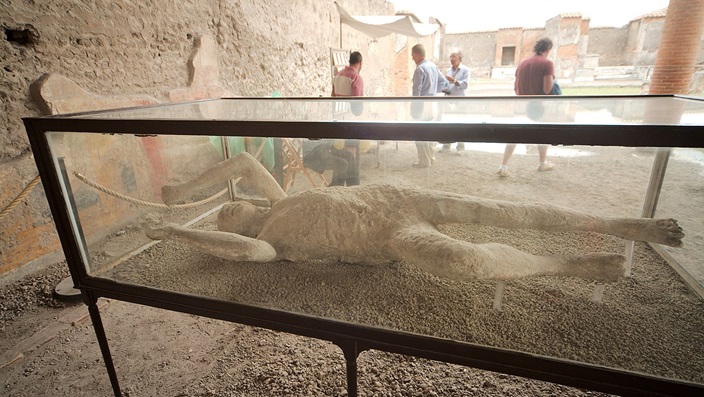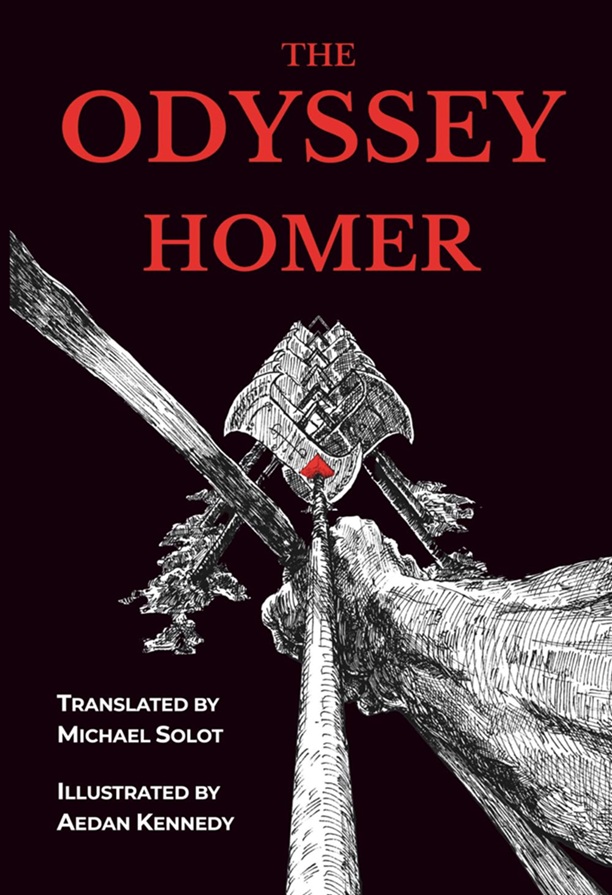.
Shades of Vesuvius
Seldom does one see horror in a tranche
De vie like that in Herculaneum
And Pompeii, when a sudden avalanche
Of heat and ash ruptured your cranium
(After you met your death in frenzied throes),
Leaving your brain a shriveled clump of glass
And you stiff in a pugilistic pose,
More dross amid the hot ash, rock and gas.
That day Vesuvius pulled out all the stops
To stop all life in those two towns inside
A few quick hours, burying houses, shops,
Brothels, and all else in a hellish slide
Of dense, pyroclastic cloud. And unseen
For a millennium, hollow vestiges
Harbored your inmost darkness, the pristine
Rigor mortis of your appendages.
Then, a sudden inflow of liquid plaster
Set. Someone broke your ashen mold to show
Your doppelganger cast from your own master,
A nature morte one’s gaze cannot outgrow,
But absorbed in your crude, unsilvered mirror,
One feels the shades of tangled, pasty freaks,
Whose turbid import edges ever nearer,
Filling our supple limbs and ruddy cheeks.
.
tranche de vie: slice of life
nature morte: still life
.
.
Stephen M. Dickey is a Slavic linguist at the University of Kansas. He has published widely on Slavic verbal categories, and has published translations of Bosnian, Croatian, and Serbian fiction and poetry including Meša Selimović’s Death and the Dervish, Borislav Pekić’s How to Quiet a Vampire, and Miljenko Jergović’s Ruta Tannenbaum. He has published poetry in various journals including Shot Glass Journal, Trinacria, The Lyric, Rat’s Ass Review, Lighten Up Online, Better Than Starbucks, Asses of Parnassus, and Blue Unicorn.















Vivid, morbid and tragic. You’ve captured the events of almost two millennia ago perfectly, Stephen, with some memorable imagery.
Thank you. I was in Denver in 1979 where I saw a traveling exhibit of the casts, and even with my limited pocket money bought a book on it that I still have along with the memories of looking at those casts.
What a good poem this is! It is a completely objective account of historical and archaeological facts, without self-absorption or navel-gazing or personal emoting. And yet it still summons up a sense of pity for the victims of the eruption, whom we can see in those unnerving plaster casts.
The rhymes here are daring (tranche – avalanche, Herculaneum – cranium) and sometimes slightly aslant (vestiges – appendages, mirror – nearer). And using the term “doppelganger” to describe the plaster shapes of long-dead inhabitants is striking. An unexpected historical subject, done with language that isn’t off-the-rack modernist plain-style, and with the unashamed use of foreign phrases — this sort of thing is becoming a hallmark of work at the SCP.
Another point: it is normally not good practice to enjamb over to the next line with a single monosyllable. But in the fifth quatrain here it works well, because the the fixity of the simple word “Set” mirrors the hardening of the liquid plaster in the space where the remains once were.
I’ll never forget the plaster cast that I saw of a chained dog, struggling in agony to break free as the pyroclastic shroud engulfed him.
Thank you for your kind comments. Interestingly, in my Kansas vernacular “mirror” and “nearer” are a perfect rhyme (not that it matters). That rhyme is hackneyed, and for me the weakest part of the poem; I wouldn’t have let myself use it except I was going back to some thoughts on mirrors that I like.
Thanks also for the comment on enjambement, which I think you have discussed with regard to another poem recently. You have explained why that run-on seemed odd to me, but also oddly appropriate.
Wow! I don’t have anything scholarly to add, except that the poem and the graphic are
riveting. The final line seems amazing with its total contrast to all that’s occurred before.
Thank you, JD, I appreciate your comment. This piece was hard to write, and I remember being surprised that I got the final turn to work out.
Whoa, Nelly! The images you generated burned me to the soul, and I remain a plaster cast of myself. If my own cheeks are still ruddy, it is only because of the heat.
Thanks Kip. Hopefully the mustache came out well in your cast.
Reminds me when an exhibit came to KC a few years back. I’ll never forget those casts. “A nature morte one’s gaze cannot outgrow,” indeed. Leading up to that section, they even staged a ‘re-enactment’ with a shaking mechanical floor and fog machine, a bit like an amusement park ride.
That would have been at Union Station, I must have missed it. I would definitely have gone had I known. I’m guessing no thugs shot everybody up in the gun-free reenactment zone.
Stephen, the poem becomes a mold in which the identity of subject (the victim) and speaker become associated in the final brilliant stanza. There the shades absorbed in the mirror (because immaterial ghosts cannot reflect) seem to take on a bit of physical pastiness like that of the plaster cast. And their “turbid import” (another immaterial thing) goes on to fill the “supple limbs and ruddy cheeks” of viewer, poet, and reader.
This last eerie feeling is prepared for in stanzas 4 and 5. For a millennium, the deceased victim has been no more than an Eliotesque “hollow man,” truly so as mere vacant “vestiges” of his body. “Vestiges” is an excellent choice, implying “vesture” or clothing. When the “ashen mold” is broken to reveal the substantial plaster doppelganger, the last “vestige” or evidence of the ancient person disappears in a rather sad way, so that his immaterial agony can become visible to others alive long after his death. The description that draws out the procedure connects this victim of Vesuvius to the present, even while it irreparably cleaves the last touch of his remaining physicality. So this one, whom you address earlier as “you stiff,” now has his link to humanity in your poetry. You did well for him!
Margaret, I am truly humbled by your comments, you can’t see me blushing in the pixels.
As for the mirror, I was inevitably going back to Rilke’s comments about mirrors in his sonnets. I keep Four Quartets memorized, and have no use for The Wasteland, but am ignorant of many of Eliot’s other works; you have gently shamed me into reading The Hollow Men as soon as I get off the screen.
With vestiges I was going back to its source, vestigium, which is any kind of footprint, track, etc.
If you think I “did well” for those in the casts, and it’s that link I was going for, that’s the highest praise I could ever expect.
As well as your rhymes, some of the phrasing I like best are: “pugilistic pose” and “the pristine Rigor mortis”. Do you happen to know–is the site still under excavation?
Thank you, “pugilistic pose” is not mine, it’s a technical term for the pose/posture resulting from the contraction of muscles/tissues in high heat, which results in a boxer-like post-mortem pose as in the photo above.
I wondered whether the site is still being excavated/investigated. The archaeologists got started in the mid-19th century I think, and some of the casts were made way back then.